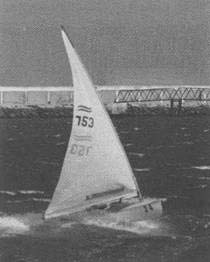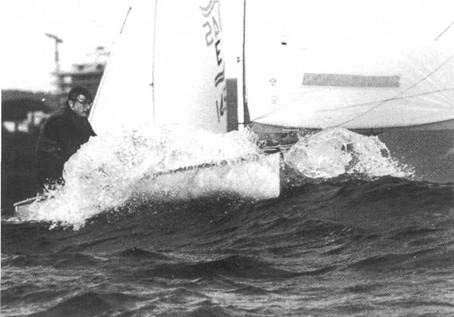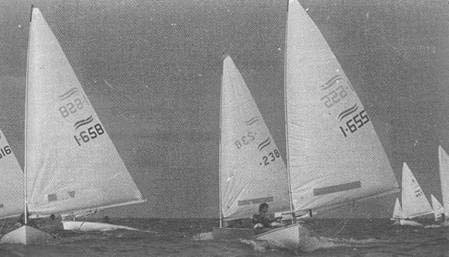Experts
The experts sail with as little centreboard as possible, hardly use the tiller, but keep balance by holding one part of the sheet. If the boat heels to weather they pull, if it heels to leeward they slacken. Thus they imitate the boat with the sail. In addition they try to stay on the face of a wave in order to sail as long as possible down the wave and as little as possible up the
It needs a lot of physical strength and practice to do this, but it is fast as long as you do not capsize. One of the difficulties is to terminate that technique, either at the leeward mark, in case you have to gybe, or worst in case the gust gets too strong. In this case try to grab the loose sheet with your tiller hand and pull in the loose parts of the sheet until you achieve a three rope purchase again. But sometimes a two rope purchase is the better than a single purchase if you are not strong enough. |
|
Sail Shape on a Reach
On a reach the fundamental requirement is an even angle of entry of the wind at the luff. Set up the fullness of the sail to match the wind conditions and then adjust the kicker such that all of the luff tell tales are flowing together -that they all lift together at the same time. If the wind eases, there will be less force on the leech and consequently it will start to hook and the sail will stall. Ease the kicker to open up the leech a bit until the tell-tales are streaming together again. If the wind increases, the extra pressure in the sail will cause the leech to open up more (giving the sail more twist). As a result the luff will not be aligned. Tension the kicker to bring the sail back into line, closing the leech and straightening the luff. Whereas too loose a kicker can be seen by the fluttering luff, too tight a kicker can be seen by the leech tell-tales looking lifeless and not streaming. It can thus be seen that on a offwind leg, the kicker needs to be adjusted almost as much as the mainsheet in order to maintain optimum sail shape.
Playing the Gusts
Special considerations apply, if the wind is changing direction and strength on the run. If you know from the last beat of frequent shifts, apply the following techniques. You have to distinguish clearly between light wind without and strong wind with the possibility of planing. In light wind you bear off in the relative gusts, in order to stay as long as possible in the ribbons of stronger wind and luff in the lulls. Either go straight down with the wind, applying the principles of running with no or very little centreboard, or go on a proper low reach with proper centreboard and a laminar flow in your sail.
|
Which of the two alternatives you choose when, depends on the other competitors. Look back over your shoulder and try to have clean air. As long as the wind does not change direction, it does not pay on the Finn to gybe downwind.
On the Run
In a steady medium wind it is fast to have a reversed steady flow along the sail from the leach to the mast, by totally slackening the Cunningham, the outhaul and the inhaul, loosening the kicker and pulling in the sheet a little bit. The actual danger of an involuntary gybe is by far not as bad as the beginner always assumes.
In medium to strong wind a good indication of a fast down wind ran is the amount of pressure on the tiller. The less pressure you have, the fewer and more gentle movements you do with the rudder, the better. Control your balance with the sheet instead - as described by imitating the boat. If it heels away slacken, it it heels towards you pull tight. Whenever possible have the Cunningham, the inhaul and the outhaul slackened on the run and the kicker fairly loose, but reset these controls on the last meters of the run and not on the first meters of the beat. |
 |
|
Waves
As the wind increases there will no doubt be waves around and the helm that can use them well can make big gains over those helms that cannot. Basically the technique consists of watching for a wave to come, steering (by trimming, balance and perhaps a little rudder) to catch the wave, surfing down the wave, loosing it and then picking up another. Always head for the troughs, and you will always be heading downhill. If you head for the crests you will always be heading uphill, which is slow. When on a wave, steer down for the lowest point that you can see so that you are always moving down a wave. If it is very windy you may find yourself ploughing into the wave in front. Head up or bear away and pick up the next wave just before you hit the wave in front. Hitting waves not only slows you down considerably, but you also run the risk of a broach. If the wind is not quite strong enough for you to keep up with the wave, you will eventually find the wave overtaking you, the crest moving underneath the boat. Pump hard to maintain position on the wave for as long as possible, steering for the lowest point of water around you, so that you are always moving fast. When you eventually fall off the the wave head up a little and look for the next one on which a catch a ride, and then bear away again once on it, pumping hard to initiate surfing. However try to stay on the same wave for as long as possible, as this is faster than a continual sequence of catching and losing waves.
Strong Winds
In stronger winds when you can plane in the gusts you can get your boat planing on a low reach but not on a run. In this case you point higher in the gusts and bear off in the lulls, exactly the opposite of what you would do in light winds, when you cannot plane even on a reach in a relative gust. Have frequent careful looks over your shoulder. If you see the water getting darker, lower your centreboard and get ready to hike out harder. Once the gust hits, luff suddenly, hike out very hard, pull in the sheet and bear of again carefully once you hit the downward face of a wave.
|
 |
In very strong winds you again apply a similar techniques as in very light wind. Bear off in the gusts straight down wind, because then the apparent wind is not so strong and you have more of a chance of surviving. Point higher in the weaker periods when you have more of a chance to manage the sudden changes of laminar and turbulent flow, when the danger of capsizing to leeward and windward is about even. On the low reaches you should sail with a fairly tight kicker as well, while the dead runs you negotiate best with full centreboard and tight kicker.
Sailing a Finn offwind in strong winds requires strong arms and quick reflexes. Your primary task is to stop the bow burying into waves because not only will this slow you down somewhat it also runs the great risk of causing a capsize. So sit well back in the boat to bring the bow up. Play the sheet constantly either from the boom or more probably direct from the floor block. |
|
The gusts need to be played on the reach and the ran. On a reach bear off to stay with the area of stronger wind for longer; come up in the lulls to find the incoming gusts. When on a ran it may pay to come up slightly to promote planing in the gusts and bear off in the lulls. |
When gybing use minimum kicker and a flat sail to survive. With no kicker on, the boom will be way above the deck and your head, and there will be little power left in it. Also beware of too tight a kicker on reach. A gust catching you unaware can heel the boat just enough to dip the boom end in the water and flip you in. Try to keep the boat dead level or heeled slightly to windward and ease the kicker slightly if you find the boom starting to skim the water. Waves just make the matter worse of course.
In very windy conditions, centreboard position is very much personal choice. As a rough guideline, a 'safe' point to have it is when the top upper most corner is just going into the case. More than this is usually unnecessary and less than this may make the boat hard to control in the waves and gusts, but will most likely be faster if you are in control of the boat. |
 |
|
Downwind Speed
When sailing upwind, the boat that reaches the windward mark first is normally the boat that has taken the best route up the beat as dictated by wind shifts, tide etc - in short, by taking the shortest route possible. Offwind, the speed of the boat has more importance than distance sailed. Always steer for clear water and clean wind. Disturbed water and wind can completely destroy downwind performance, so a route should be steered clear of all other boats and obstructions. You may find yourself taking a very roundabout route to the leeward mark but if you can maintain full speed all the way while others are only travelling at 50% speed you will obviously get there quicker. Always try to sail fast as possible, by powering up the sail, by sailing by the lee, easing kicker and reversing flow, raising the centreboard and reducing wetted surface area and by watching the gusts and playing the waves.
|
|